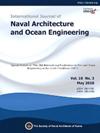基于顺序生成的管道支架智能布置方法
IF 3.9
3区 工程技术
Q2 ENGINEERING, MARINE
International Journal of Naval Architecture and Ocean Engineering
Pub Date : 2025-01-01
DOI:10.1016/j.ijnaoe.2025.100661
引用次数: 0
摘要
管道支架的布置是保证管道安全的关键,在考虑管道空间布置、管道特性和技术约束的前提下,将安全放在首位。由于设计过程的复杂性,长期依赖人工设计,导致设计阶段的效率瓶颈显著。介绍了一种基于顺序生成的LPS设计框架。最初,特征向量是通过关注重要的设计因素来定义的。随后,引入知识驱动的变步长采样方法,在不影响效率的前提下优化效率。然后,通过基于多头注意的编码器(Multi-Heads-Attention - based Encoder, MHA-Encoder)对采样序列进行处理,预测序列中每个点的标签,这些标签表示支持类型,其索引表示放置位置。最后,通过实际设计案例验证了该方法的有效性,其精度为91.55%,误差最小,设计周期缩短了40倍。本文章由计算机程序翻译,如有差异,请以英文原文为准。
A sequential-generation-based intelligent method for layout of pipeline supports
The layout of pipeline supports (LPS) is essential for ensuring the safety of pipeline, which prioritize safety while considering spatial arrangement, pipeline characteristics, and technical constraints. Due to the complexity of the design process, there has been a long-term reliance on manual design, resulting in significant efficiency bottlenecks in the design phase. The research introduces a design framework for LPS based on sequential generation. Initially, a feature vector is defined by focusing on the significant design factors. Subsequently, a knowledge-driven variable-step-size sampling method introduces to optimize efficiency without compromising effectiveness. Then, the sampling sequence is processed through a Multi-Heads-Attention based Encoder (MHA-Encoder) to predict labels for each point in the sequence, which indicating the support type and its index signifying the placement. Finally, the proposed method’s validity was confirmed via real-world design cases, demonstrating an accuracy of 91.55% with minimal errors and a 40-fold reduction in the design cycle.
求助全文
通过发布文献求助,成功后即可免费获取论文全文。
去求助
来源期刊

International Journal of Naval Architecture and Ocean Engineering
ENGINEERING, MARINE-
CiteScore
4.90
自引率
4.50%
发文量
62
审稿时长
12 months
期刊介绍:
International Journal of Naval Architecture and Ocean Engineering provides a forum for engineers and scientists from a wide range of disciplines to present and discuss various phenomena in the utilization and preservation of ocean environment. Without being limited by the traditional categorization, it is encouraged to present advanced technology development and scientific research, as long as they are aimed for more and better human engagement with ocean environment. Topics include, but not limited to: marine hydrodynamics; structural mechanics; marine propulsion system; design methodology & practice; production technology; system dynamics & control; marine equipment technology; materials science; underwater acoustics; ocean remote sensing; and information technology related to ship and marine systems; ocean energy systems; marine environmental engineering; maritime safety engineering; polar & arctic engineering; coastal & port engineering; subsea engineering; and specialized watercraft engineering.
 求助内容:
求助内容: 应助结果提醒方式:
应助结果提醒方式:


